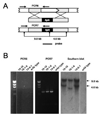PARP is involved in replicative aging in Neurospora crassa
- PMID: 20045739
- PMCID: PMC2841980
- DOI: 10.1016/j.fgb.2009.12.012
PARP is involved in replicative aging in Neurospora crassa
Abstract
Modification of proteins by the addition of poly(ADP-ribose) is carried out by poly(ADP-ribose) polymerases (PARPs). PARPs have been implicated in a wide range of biological processes in eukaryotes, but no universal function has been established. A study of the Aspergillus nidulans PARP ortholog (PrpA) revealed that the protein is essential and involved in DNA repair, reminiscent of findings using mammalian systems. We found that a Neurospora PARP orthologue (NPO) is dispensable for cell survival, DNA repair and epigenetic silencing but that replicative aging of mycelia is accelerated in an npo mutant strain. We propose that PARPs may control aging as proposed for Sirtuins, which also consume NAD+ and function either as mono(ADP-ribose) transferases or protein deacetylases. PARPs may regulate aging by impacting NAD+/NAM availability, thereby influencing Sirtuin activity, or they may function in alternative NAD+-dependent or NAD+-independent aging pathways.
Figures











Similar articles
-
Genetic dissection of PARylation in the filamentous fungus Neurospora crassa.Methods Mol Biol. 2011;780:427-41. doi: 10.1007/978-1-61779-270-0_26. Methods Mol Biol. 2011. PMID: 21870276
-
Overexpression of PaParp encoding the poly(ADP-ribose) polymerase of Podospora anserina affects organismal aging.Mech Ageing Dev. 2011 Jan-Feb;132(1-2):33-42. doi: 10.1016/j.mad.2010.11.003. Epub 2010 Dec 9. Mech Ageing Dev. 2011. PMID: 21145908
-
Crosstalk between poly(ADP-ribose) polymerase and sirtuin enzymes.Mol Aspects Med. 2013 Dec;34(6):1168-201. doi: 10.1016/j.mam.2013.01.004. Epub 2013 Jan 25. Mol Aspects Med. 2013. PMID: 23357756 Free PMC article. Review.
-
Using Clickable NAD+ Analogs to Label Substrate Proteins of PARPs.Methods Mol Biol. 2017;1608:95-109. doi: 10.1007/978-1-4939-6993-7_8. Methods Mol Biol. 2017. PMID: 28695506
-
A new facet of ADP-ribosylation reactions: SIRTs and PARPs interplay.Front Biosci (Landmark Ed). 2015 Jan 1;20(3):458-73. doi: 10.2741/4319. Front Biosci (Landmark Ed). 2015. PMID: 25553461 Review.
Cited by
-
A uvs-5 strain is deficient for a mitofusin gene homologue, fzo1, involved in maintenance of long life span in Neurospora crassa.Eukaryot Cell. 2013 Feb;12(2):233-43. doi: 10.1128/EC.00226-12. Epub 2012 Dec 7. Eukaryot Cell. 2013. PMID: 23223037 Free PMC article.
-
Functions of the poly(ADP-ribose) polymerase superfamily in plants.Cell Mol Life Sci. 2012 Jan;69(2):175-89. doi: 10.1007/s00018-011-0793-4. Epub 2011 Aug 23. Cell Mol Life Sci. 2012. PMID: 21861184 Free PMC article. Review.
-
A Matter of Scale and Dimensions: Chromatin of Chromosome Landmarks in the Fungi.Microbiol Spectr. 2017 Jul;5(4):10.1128/microbiolspec.funk-0054-2017. doi: 10.1128/microbiolspec.FUNK-0054-2017. Microbiol Spectr. 2017. PMID: 28752814 Free PMC article. Review.
-
Molecular Insights into Poly(ADP-ribose) Recognition and Processing.Biomolecules. 2012 Dec 21;3(1):1-17. doi: 10.3390/biom3010001. Biomolecules. 2012. PMID: 24970154 Free PMC article.
-
Cellular ATP redistribution achieved by deleting Tgparp improves lignocellulose utilization of Trichoderma under heat stress.Biotechnol Biofuels Bioprod. 2024 Apr 18;17(1):54. doi: 10.1186/s13068-024-02502-8. Biotechnol Biofuels Bioprod. 2024. PMID: 38637859 Free PMC article.
References
-
- Ahel I, Ahel D, Matsusaka T, Clark AJ, Pines J, et al. Poly(ADP-ribose)-binding zinc finger motifs in DNA repair/checkpoint proteins. Nature. 2008;451:81–85. - PubMed
-
- Ame JC, Fouquerel E, Gauthier LR, Biard D, Boussin FD, et al. Radiation-induced mitotic catastrophe in PARG-deficient cells. Cell Sci. 2009a;122:1990–2002. - PubMed
-
- Ame JC, Hakme A, Quenet D, Fouquerel E, Dantzer F, et al. Detection of the Nuclear Poly(ADP-ribose)-Metabolizing Enzymes and Activities in Response to DNA Damage. Methods Mol Biol. 2009b;464:267–283. - PubMed
-
- Ame JC, Rolli V, Schreiber V, Niedergang C, Apiou F, et al. PARP-2, A novel mammalian DNA damage-dependent poly(ADP-ribose) polymerase. J Biol Chem. 1999;274:17860–17868. - PubMed
-
- Ame JC, Spenlehauer C, de Murcia G. The PARP superfamily. Bioessays. 2004;26:882–893. - PubMed
Publication types
MeSH terms
Substances
Associated data
- Actions
Grants and funding
LinkOut - more resources
Full Text Sources

